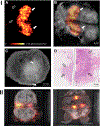A review of recent and emerging approaches for the clinical application of Cerenkov luminescence imaging
- PMID: 36845872
- PMCID: PMC9957555
- DOI: 10.3389/fphy.2021.684196
A review of recent and emerging approaches for the clinical application of Cerenkov luminescence imaging
Abstract
Cerenkov luminescence (CL) is a blue-weighted emission of light produced by a vast array of clinically approved radioisotopes and LINAC accelerators. When β particles (emitted during the decay of radioisotopes) are present in a medium such as water or tissue, they are able to travel faster than the speed of light in that medium and in doing so polarize the molecules around them. Once the particle has left the local area, the polarized molecules relax and return to their baseline state releasing the additional energy as light (luminescence). This blue glow has commonly been used to determine the output of nuclear power plant cores and, in recent years, has found traction in the preclinical and clinical imaging field. This brief review will discuss the technology which has enabled the emergence of the biomedical Cerenkov imaging field, recent pre-clinical studies with potential clinical translation of Cerenkov luminescence imaging (CLI) and the current clinical implementations of the method. Finally, an outlook is given as to the direction in which the field is heading.
Keywords: Cerenkov; Cherenkov; clinical; dosimetry; image-guided; preclinical; review; surgery.
Conflict of interest statement
9Conflict of interest The authors declare that the research was conducted in the absence of any commercial or financial relationships that could be construed as a potential conflict of interest.
Figures






Similar articles
-
Detection of Shortwave-Infrared Cerenkov Luminescence from Medical Isotopes.J Nucl Med. 2023 Jan;64(1):177-182. doi: 10.2967/jnumed.122.264079. Epub 2022 Jun 23. J Nucl Med. 2023. PMID: 35738902 Free PMC article.
-
Cerenkov imaging - a new modality for molecular imaging.Am J Nucl Med Mol Imaging. 2012;2(2):163-73. Epub 2012 Mar 28. Am J Nucl Med Mol Imaging. 2012. PMID: 23133811 Free PMC article.
-
Cerenkov luminescence imaging (CLI) for image-guided cancer surgery.Clin Transl Imaging. 2016;4(5):353-366. doi: 10.1007/s40336-016-0183-x. Epub 2016 May 24. Clin Transl Imaging. 2016. PMID: 27738626 Free PMC article. Review.
-
Innovations in Nuclear Imaging Instrumentation: Cerenkov Imaging.Semin Nucl Med. 2018 Jul;48(4):359-366. doi: 10.1053/j.semnuclmed.2018.02.007. Epub 2018 Mar 16. Semin Nucl Med. 2018. PMID: 29852945 Free PMC article. Review.
-
Utilizing the power of Cerenkov light with nanotechnology.Nat Nanotechnol. 2017 Feb 7;12(2):106-117. doi: 10.1038/nnano.2016.301. Nat Nanotechnol. 2017. PMID: 28167827 Free PMC article. Review.
Cited by
-
Direct in-water radiation dose measurements using Cherenkov emission corrected signals from polarization imaging for a clinical radiotherapy application.Sci Rep. 2022 Jun 10;12(1):9608. doi: 10.1038/s41598-022-12672-w. Sci Rep. 2022. PMID: 35688843 Free PMC article.
-
Luminescence Probes in Bio-Applications: From Principle to Practice.Biosensors (Basel). 2024 Jul 8;14(7):333. doi: 10.3390/bios14070333. Biosensors (Basel). 2024. PMID: 39056609 Free PMC article. Review.
-
Cerenkov radiation-activated probes for deep cancer theranostics: a review.Theranostics. 2022 Oct 24;12(17):7404-7419. doi: 10.7150/thno.75279. eCollection 2022. Theranostics. 2022. PMID: 36438500 Free PMC article. Review.
-
Current clinical applications of Cerenkov luminescence for intraoperative molecular imaging.Eur J Nucl Med Mol Imaging. 2024 Aug;51(10):2931-2940. doi: 10.1007/s00259-024-06602-3. Epub 2024 Jan 20. Eur J Nucl Med Mol Imaging. 2024. PMID: 38243119 Free PMC article. Review.
-
212Pb in targeted radionuclide therapy: a review.EJNMMI Radiopharm Chem. 2025 Jul 1;10(1):34. doi: 10.1186/s41181-025-00362-7. EJNMMI Radiopharm Chem. 2025. PMID: 40591218 Free PMC article. Review.
References
-
- Curie M, Curie P, and Bemont G, Another new radio-active element. CR, 1898. 127: p. 1215–1217.
-
- Čerenkov P. Visible light from pure liquids under the impact of γ-rays. in CR (Dokl.) Acad. Sci. URSS. 1934.
-
- Tamm I. and Frank I. Coherent radiation of fast electrons in a medium. in Dokl. Akad. Nauk SSSR. 1937.
-
- Arkani M. and Gharib M, Reactor core power measurement using Cherenkov radiation and its application in Tehran Research Reactor. Annals of Nuclear Energy, 2009. 36(7): p. 896–900.
Grants and funding
LinkOut - more resources
Full Text Sources
Research Materials
Miscellaneous
